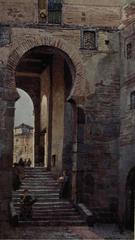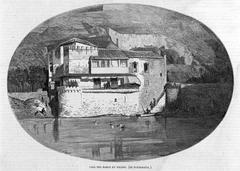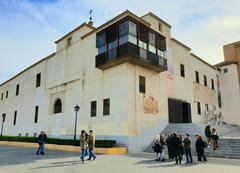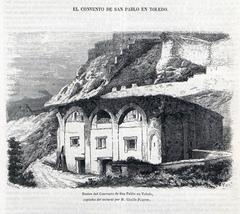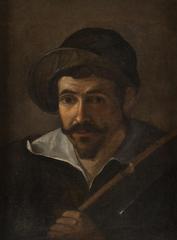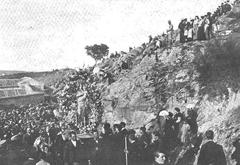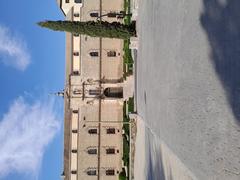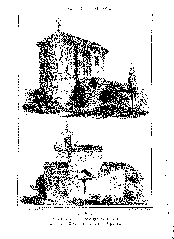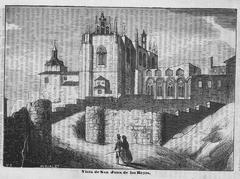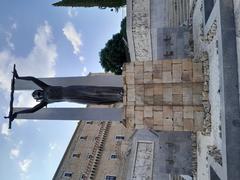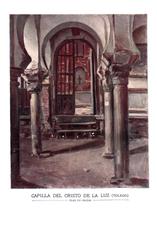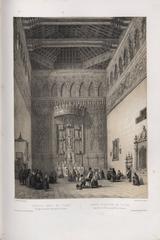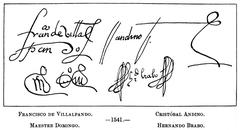Convento de Santa Clara la Real, Toledo, Spain: Visiting Hours, Tickets, and Historical Sites Guide
Date: 04/07/2025
Introduction
Nestled in the heart of Toledo’s historic center, the Convento de Santa Clara la Real stands as a testament to Spain’s rich spiritual, artistic, and cultural heritage. Founded in 1369 by Doña María Meléndez, this convent has played a vital role in the city’s religious and social history, offering a living example of the intersection between Christian, Islamic, and Jewish traditions (Patrimonio Cultural de Castilla-La Mancha). Today, the convent is not only a remarkable architectural monument but also an active spiritual community, welcoming visitors to explore its art, history, and enduring traditions.
This guide provides a comprehensive overview for visitors, including historical context, architectural highlights, details on visiting hours, tickets, accessibility, guided tours, and travel tips. Whether you are an art enthusiast, pilgrim, or traveler, the Convento de Santa Clara la Real offers a profound and enriching experience within Toledo’s vibrant historical landscape.
Table of Contents
- Introduction
- Historical Context and Religious Significance
- Role in Toledo’s Religious Landscape
- Spiritual Practices and Daily Life
- Artistic and Cultural Contributions
- Social and Charitable Impact
- Pilgrimage and Devotional Traditions
- Community Engagement and Heritage Preservation
- Visiting Hours, Tickets, and Accessibility
- Guided Tours and Special Events
- Nearby Attractions and Travel Tips
- Guidelines for Respectful Visitation
- Frequently Asked Questions (FAQ)
- Architectural and Artistic Highlights
- Conservation and Preservation Efforts
- Unique Visitor Experiences
- Practical Information
- Conclusion
- References
Historical Context and Religious Significance
The Convento de Santa Clara la Real was established during a period of significant social and religious transformation in Castile. Founded by the noblewoman Doña María Meléndez in 1369, it provided a place of spiritual retreat for women of noble birth, aligning with the broader European rise of female monasticism in the late Middle Ages (Patrimonio Cultural de Castilla-La Mancha).
Affiliated with the Order of Saint Clare (the Poor Clares), the convent reflected the Franciscan values of poverty, contemplation, and community service. The nuns’ presence contributed significantly to Toledo’s religious landscape, especially during the Reconquista and Counter-Reformation periods, serving as a bastion of Catholic orthodoxy and spiritual guidance (Franciscanos.org; Toledo Turismo).
Role in Toledo’s Religious Landscape
Toledo, renowned as the “City of Three Cultures,” has long been a crossroads of Christian, Jewish, and Islamic traditions. The convent played a pivotal role in reinforcing Catholic identity, offering a space for prayer, education, charitable works, and the preservation of sacred relics and art (Toledo Turismo).
The nuns contributed to the vitality of local religious life, organizing processions, supporting parishes, and providing spiritual counsel to both the elite and commoners.
Spiritual Practices and Daily Life
Life in the convent adhered strictly to the Rule of Saint Clare, emphasizing poverty, humility, and communal living. The daily rhythm included prayer, contemplation, manual labor, and participation in the Divine Office and Eucharistic celebrations, often accompanied by Gregorian chant (Orden de Santa Clara). Major feasts, such as the Feast of Saint Clare (August 11), attracted pilgrims and underscored the convent’s spiritual significance.
Artistic and Cultural Contributions
The convent is renowned for its remarkable art collection, reflecting the spiritual aspirations and artistic excellence of the community. Its treasures span the Gothic, Renaissance, and Baroque periods, with works by artists such as Jorge Manuel Theotocópuli (El Greco’s son), Luis Tristán, Diego de Aguilar, and Juan Bautista Monegro (Museo de Santa Clara; Arteguias).
The main altarpiece, a polychrome woodcarving, and the intricate Mudéjar decorations of the cloisters and chapels, highlight the blending of Christian and Islamic artistic traditions in Toledo. The convent’s art serves both devotional and educational purposes, illustrating key moments in Christian history and theology.
Social and Charitable Impact
Throughout its history, the convent has played a crucial role in supporting Toledo’s poor and marginalized. During crises such as plague outbreaks, it served as a refuge for the sick and needy (Toledo Olvidado). Today, the nuns continue their charitable mission and support the convent’s upkeep through the sale of traditional sweets and crafts, contributing to Toledo’s living cultural identity.
Pilgrimage and Devotional Traditions
The convent remains a site of pilgrimage, especially during the annual novena in honor of Saint Clare. Relics preserved within the convent, as well as the serene chapels and oratories, continue to attract those seeking spiritual renewal (Toledo Turismo).
Community Engagement and Heritage Preservation
While the nuns maintain a cloistered life, the convent has long engaged with Toledo’s community through education, charity, and spiritual direction. Its archives preserve valuable records of the city’s religious and social history (Archivo Histórico Provincial de Toledo). The convent’s rituals, chants, and traditions are carefully maintained and passed on, forming an integral part of Toledo’s intangible cultural heritage (UNESCO Intangible Heritage).
Visiting Hours, Tickets, and Accessibility
- Visiting Hours: Public visits are typically available on Saturdays from 10:00 AM to 2:00 PM. Visits at other times may require prior appointment (santaclaratoledo.es).
- Tickets: Admission is about €3 per person. Tickets can be purchased onsite or reserved in advance via the official website or by phone.
- Guided Tours: Available by appointment (recommended for groups), guided tours provide in-depth insight into the convent’s history and art.
- Accessibility: Some areas are accessible, but due to the historic nature of the building, certain sections may be challenging for visitors with reduced mobility. Contact the convent in advance to discuss specific needs.
Guided Tours and Special Events
Guided tours, available in various languages, offer detailed commentary on the convent’s history and art. During special events such as Semana Santa (Holy Week), the convent hosts unique access tours and tastings of traditional sweets like torrijas (eldiario.es).
Nearby Attractions and Travel Tips
Located in Toledo’s Casco Histórico, the convent is close to landmarks such as the Toledo Cathedral, Alcázar, and Synagogue of Santa María la Blanca. Wear comfortable shoes for cobblestone streets, and plan accordingly for peak tourist times.
Guidelines for Respectful Visitation
- Dress modestly and maintain quiet, especially in chapels and cloisters.
- Photography is permitted in some areas, but flash and photography near fragile artworks may be restricted.
- Support the community by purchasing convent-made crafts and sweets.
- Be mindful of areas reserved for prayer and the privacy of the resident nuns (Toledo Turismo).
Frequently Asked Questions (FAQ)
What are the visiting hours?
Saturdays, 10:00 AM–2:00 PM. Other days by appointment.
How much is admission?
Approximately €3 per person.
Are guided tours available?
Yes, by appointment.
Is the convent accessible for people with disabilities?
Some areas are accessible; contact in advance for details.
Can I take photographs?
Permitted in some areas, with restrictions for fragile works.
Architectural and Artistic Highlights
Mudéjar and Renaissance Fusion
The convent’s architecture is a prime example of the harmonious blend of Mudéjar and Renaissance styles. The original Mudéjar houses, dating from the 12th to 14th centuries, are evident in the Patio del Naranjo, with horseshoe arches and intricate brickwork (turismo.toledo.es).
The 15th-century Claustro de los Laureles, with its vibrant Talavera tilework, marks the transition to Renaissance design while retaining Mudéjar elements (santaclaratoledo.es).
Patios and Cloisters
- Patio del Naranjo: Features orange trees and Islamic garden design elements.
- Claustro de los Laureles: Showcases Renaissance and Mudéjar fusion, with 16th-century Talavera ceramics (arteguias.com).
The Church and Sacred Art
The church houses paintings by Jorge Manuel Theotocópuli, Luis Tristán, and Diego de Aguilar, as well as 16th-century walnut choir stalls, 15th-century murals, and 14th-century sculptures (turismo.toledo.es; santaclaratoledo.es).
Hispano-Muslim Decorative Elements
The Sala Capitular and Sala de Profundis retain Hispano-Muslim features such as horseshoe arches, ornamental plasterwork, and geometric tilework, reflecting the city’s multicultural legacy (conventosdetoledo.com).
Talavera Ceramics and Liturgical Objects
The convent’s collection includes splendid examples of Talavera tilework and a treasury of liturgical silver and goldsmithing from the 16th to 18th centuries (turismo.toledo.es; santaclaratoledo.es).
Conservation and Preservation Efforts
Recognized as a Bien de Interés Cultural since 1981, the convent is protected by heritage laws. Ongoing restoration projects focus on preserving murals, wooden ceilings, and other fragile elements (arteguias.com).
Unique Visitor Experiences
- Immersive Artistic Journey: Explore authentic medieval spaces and admire Mudéjar and Renaissance art.
- Artisan Products: Purchase handmade embroidery, textiles, and traditional sweets made by the nuns (historiasdetoledo.com).
- Spiritual Significance: Experience the contemplative legacy of the Poor Clares (santaclaratoledo.es).
Practical Information
- Contact: +34 925 460 965 or +34 640 239 857 (santaclaratoledo.es)
- Location: Historic quarter of Toledo, near major monuments.
- Official Website: https://www.conventosantaclaratoledo.es
- Tourism Office: Toledo Turismo
Conclusion
A visit to the Convento de Santa Clara la Real offers a rare opportunity to immerse yourself in Toledo’s spiritual and artistic legacy. With its harmonious blend of Mudéjar and Renaissance styles, historic chapels, serene cloisters, and a wealth of sacred art, the convent encapsulates centuries of cultural fusion and devotion. Plan your visit in advance, attend a guided tour, and support the living traditions of this remarkable community by enjoying authentic artisanal products. For up-to-date information, consult the official website and local tourism platforms. The Convento de Santa Clara la Real stands as a beacon of Toledo’s enduring heritage, inviting visitors to reflect, learn, and be inspired within its historic walls (Official Convento Website).
References
- Patrimonio Cultural de Castilla-La Mancha
- Franciscanos.org
- Toledo Turismo
- Orden de Santa Clara
- Museo de Santa Clara
- Arteguias
- Toledo Olvidado
- Archivo Histórico Provincial de Toledo
- UNESCO Intangible Heritage
- eldiario.es
- Official Convento de Santa Clara La Real Website
- Asociación de Amigos de los Conventos de Toledo
- turismo.toledo.es
- santaclaratoledo.es
- conventosdetoledo.com
- historiasdetoledo.com
